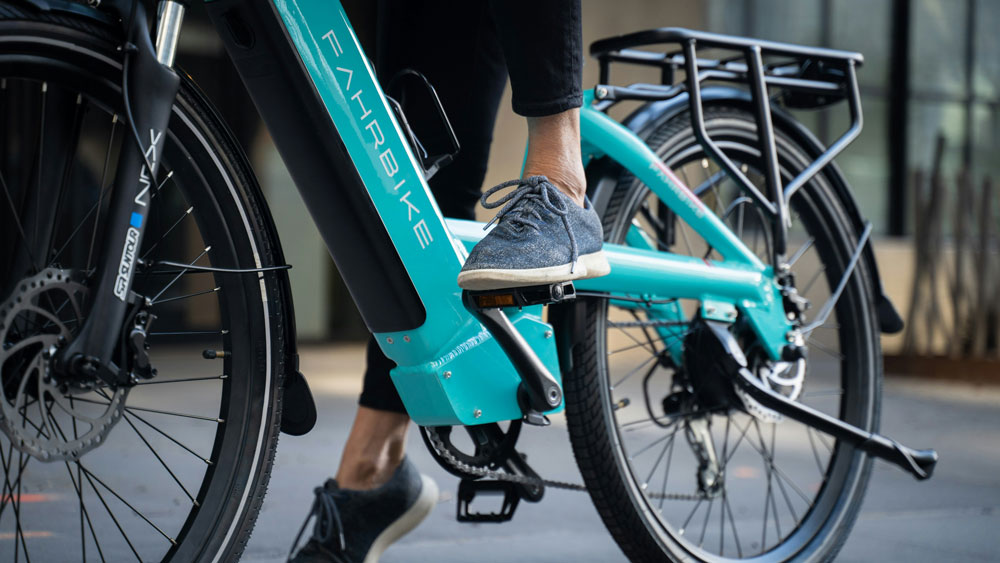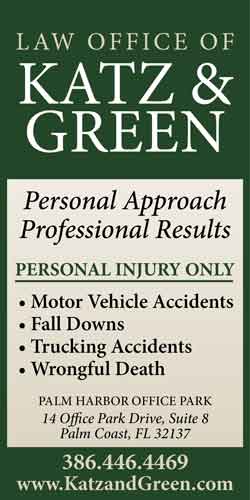
“This is not my intent to be a sixth Councilman up here,” Andy Dance, the former school board member, current chair of the County Commission and–who knows–future mayor of Palm Coast, told the Palm Coast City Council last night as the council readied to enact the city’s ebike ordinance, which bore his imprint.
The council approved the ordinance 4-1, with Council member Theresa Pontieri voting against only because it preserved an age limit: children younger than 11 will not be allowed on ebikes on public paths. Pontieri considers that overreach.
Class 1 and 2 ebikes, pedal- and throttle-assisted, will have speed limits of 20 miles per hour. Class 3 bikes, which are pedal-assisted, will be limited to 28 miles per hour. (See an explanation of the three classes here.) All ebikes must have their classification number fixed on the bike. Off-road bikes will not be allowed on public sidewalks. Riders will have to carry a government-issued photo identification. School IDs are permissible. Bike tampering could result in confiscation of the bike. Riders must follow the rules of the road.
“I appreciate that you guys are seriously considering some of my edits,” Dance, who also chairs the county’s traffic-safety team and routinely rides an ebike, said. He’d added one more edit since the last version: an ebike speed limit for school zones, “because you have parents, you have kids walking to school, and I think it’s important to reduce those speeds down to pedestrian speed during school, flashing times and at crosswalks.”
As was the case during previous council discussions on the ordinance, the age limit was strongly debated, with Dance falling on the side of an age limit. “Ebikes are distinctly different from regular bikes,” he said. “They are heavy. They are anywhere from 50 to 70 to 80 pounds. They can’t stop as quickly, and they hit things with different force. So if you are a pedestrian or you’re going to feel the impact differently, so that’s where the age is important.”
Safety is the goal, but government should not be “engaging in the overreach and trying to parent our residents’ kids,” Pontieri said. “Realistically, kids that age can’t ride them. You don’t see a lot of them riding them. Now, I think we’re talking about kind of a non-issue, but still, overstepping in my concern is precedent. What precedent are we setting by telling parents they can or cannot allow their children to ride a certain type of bicycle.” To Council member Ty Miller–who sees younger children ride them–lines of the sort are commonly drawn by regulations.
There were comparatively few public comments this time. There was a concern about enforcement and the cost of enforcement, though a resident’s suggestion that “supporting that ordinance cost us another million dollars to go out and track down these kids and write tickets and do all the administration with it” seemed exaggerated. Still, cost estimates were not linked to the ordinance, and the resident–Mark Webb–was referring to the Sheriff’s Office’s annual budget requests, which have been steep. The sheriff originally recommended to Palm Coast to write the ordinance.
“The whole reason that we initially started discussing this ordinance was not the nitty gritty of these rabbit holes we’ve kind of gone down,” Pontieri said. “The whole point was because we had quite a few incidents of reckless driving with some of the bikes that have been modified,” enabling motorized dirtbike riding under the guise of ebikes. Pontieri doubted that Webb’s scenario would happen, especially since the sheriff’s annual requests are based on a broader master plan, not day-to-day developments.
Dance acknowledged the importance of protecting pedestrians but stressed what he’s been advocating for in connection with ebike safety: the importance of making such ordinances part of a larger whole that recognizes the importance of connected modes of transportation, and the fact that ebikes are an increasingly popular and necessary mode of transportation, especially for older people. He said it “makes sense for the county to consider this in the near future,” meaning a similar ordinance.
![]()






























Mike says
28 MPH is to fast for an 11yr old
Cisco says
It really is too broad in some areas. It should limit sidewalk to 15 mph and to stop and observe traffic laws at all intersections regardless if a stop sign is on the sidewalks at said intersections, or the city is probaly going to be facing lawsuits for not protecting these idiots. I have personally seen kids not stopping on the road going from Rymfire to Ryan and cars are turning onto Ryan without even seeing them at the speed they are going. I will state that any injuries is going to cause the city problems, and we as citizens will be left with the bill ,I am afraid. The Sheriff department already have these bikes theirselves and it will take heavy handed enforcement at first to get not only the kids attention but also the parents and adults riding these bikes .If the Sheriff says it will cost more money, he can use car sharing for his deputies unless they are specialized deputies always on call. The citizens of Palmcoast can’t afford special perks for government employees. We can’t just spend all of the revenues just because they are coming in and not put aside substantial reserves for unknown future problems. I don’t know of any person that uses all of their credit limits on their credit cards unless they are fools with their money, but I am seeing alot of that particularly because of the high cost of living in Florida, all city departments should DOZE theirselves to see where they can cut,because after Homestead taxes are taken away, they will be getting alot less and will need a big rainy day reserve 😉
Stephen Playe, M.D. says
Anyone who thinks e-bikes are safe near pedestrians should ride one at 28 (or even 20) mph past your child or grandchild as they walk along.
Exposing pedestrians to e-bikes is a recipe for tragedy.
Mark Webb says
I want to understand how a ordnance can be voted on after a workshop and 2 readings when there where many revisions that that were required?
The ordnance wasn’t in its final draft and the council still voted to approve.
Is that the process the citizens expect for our elected officials?
Just my thoughts.
Gkh says
Sorry, but E-bikes are motor vehicles, and should be classified as much! That would take care of “age limits”, registration, and insurance requirements. Who is responsible for property damage, physical damage, and potential death? The parents of said children?
JimboXYZ says
I think the age restriction is a good thing. At a certain age, kids aren’t going to understand that they need to be riding on the correct side of the road where there are & aren’t the wider sidewalks/trails (Belle Terre).
The 17 year old that was eun over by the dump truck for residential construction, he was salmon-ing in the wrong direction of the flow of traffic. He became a fatality for that error of riding against & into traffic. Other terms like being doored are also frequent enough. Dooring is when a motorist in a parked car opens their door on a cyclist riding in the roadway. When a bike hits that door, they get knocked & ejected into the traffic lane, the parked car doesn’t move, the driver & door are injured/damaged, the bike is too for rim & frame compression. As Palm Coast & Flagler County grows the traffic is getting worse every day for it. And what used to be relatively safe is even more dangerous than it was.
Just me, I’d rather spend $ 90K on educating bicyclists of all ages, instead of focusing on motorcycle awareness. Motorcyclists at their age(s) should be smart enough to figure out that hitting the curb at +/- the speed limits is a crash at the very least, fatality at worst. But an 11 year old child ? Some of them aren’t that bright to begin with, telling them they need to learn the rules of the road at that age ? Most parents & children don’t realize that under the age of 16 and a bicycle helmet is REQUIRED by state statute (laws) for those that don’t what a statute is. In many ways, the state statutes governed all of this, the ordinance close any ambiguities that the one’s getting citations attempt to lawyer their way out of. Remember the kid they airlifted to Orlando for not wearing a helmet ? A helmet & maybe he would’ve had a mild concussion at worst ?
https://www.npr.org/sections/health-shots/2014/05/15/312455673/dont-salmon-dont-shoal-learning-the-lingo-of-safe-cycling
https://crashcallash.com/bicycle-salmoning-unsafe-for-everyone-on-the-road/
https://flaglerlive.com/laramie-crash/
https://www.clickorlando.com/traffic/2024/09/16/17-year-old-on-motorized-bike-killed-in-crash-with-dump-truck-in-flagler-county/
https://flaglerlive.com/pelton-injury/
https://bayareabicyclelaw.com/rules-of-the-road-riding-with-the-flow-of-traffic/
Citizen says
Another reason palm coast is a disgusting, corrupt place to live. Between corrupt county officials, judges like France and corrupt cops like good ol boy Rick, this place is trash. Staley is a nazi. Police state. Now they will have more reasons to illegally stop people on bikes now. You cant enforce having to ride a bicycle with a photo ID if its not road certified. Its a bike. Stupid as all hell. But the old people will vote for it because they believe the lies thrown at them by the county to stay in official positions and buy votes.
Kathleen Doherty says
Electric bikes need to have reflectors on them and lights when it’s dark!! I’m seeing bikes out after dark and you just can’t see them. Add that to the rules, please.
Good Deal says
All right, Cooler minds prevail! Proud of you guys! I can live with these rules, impossible to break even for my beloved class one E-bike that does 20-22MPH I bought for my 12 year old daughter (now 14) but over the last 3 years has saved my butt against Enterprise car rental fees when various car problems arose, allowing me to get to work 4 miles across town expeditiously. Now outfitted with front basket and rear rack it is a joy to take to the grocery store and other light errands where I don’t need to drive a 5,000 pound automobile to fetch a gallon of milk. I still highly recommend a helmet though not required for a 200MPH Suzuki either…
Noebikesonsidewalks says
How would you like to be walking down a sidewalk and have an ebike pass you inches away at 28 miles per hour? We just encountered an e-bike walking on a sidewalk on A1A whose driver refused to go around us and had to bring her e-bike to a complete halt. She did not sound her horn. E-bike riders for the most part are afraid to move over in the grass or go into the road when they encounter pedestrians. Pedestrians have the right of way. Cars must give bicycles 3 feet when passing, yet e-bikes will pass a pedestrian so close they are almost sideswiping you. And when you complsin to them about not alerting you, they give you the finger!
A Concerned Observer says
Thank you, THANK YOU! This is sorely needed. Children on E-Bikes, Scoters and Skate Boards have no idea of how dangerous these are, to not only to themselves, but to pedestrians on side walks and walking paths throughout the city. They routinely dart across crosswalks with absolutely no thought of cars that have the right of way over people riding, rather than walking them across intersecting roadways. Yes, a bicycle ridden across a sidewalk is a vehicle. Someone walking a bike across a crosswalk is a pedestrian. I can only hope that Flagler County will see this and carry it over county wide.
Laurel says
Government issued IDs? To ride bikes? Safety my ass. Gee, overreaching, over controlling government, where’s the seatbelts? “Welcome to Free Florida.” Is this how it is up north where y’all came from?
Sillylaw says
I’m not a fan of E bikes but you can’t regulate them like this, the town has no authority and one lawsuit will quickly overturn turn this. The issue is a statewide (or maybe even national) challenge not a local town ordinance. All people on PC staff are grossly unqualified to make any rules in general and they have absolutely no qualifications of any kind worth noting to allow them to rule on what parents have decided for their unique circumstances is fine for their kids. In a village full of idiots like Palm Coast, it’s tough to know if this group are truly our village idiots, but they are all certainly in the running for the title. For better or worse, we live in a country that a long ago decided you can’t regulate stupid. Most of Florida wouldn’t even exist if regulated it. You can’t pretend to be all about freedom on the things you like and then not be all about freedom when you want to regulate things you don’t like. Personally, I like regulation, but I like good regulation and I like a town that’s committed to solving its problems not trying to tell people what to do. You do enough of that already thank you very much. Now should the sheriff want to pull over those kids and let them know that their parents are bad parents, well that’s sort of shaming would be good old-fashioned community policing and most of us would be ok with it, but you don’t take away rights to solve nothing and you don’t require policies like where you have to carry an ID and presume the law has a right to ask you for it on a bike. It’s ridiculous and has all kinds of legal implications for civil rights and future misuse and is most certainly the only reasons they passed this to use the law against the homeless. Bunch of idiots and I look forward to voting against them in the next election.
Republican Dave says
Government issued ID? WTF? Government is getting into your life earlier and earlier. Parents have enough sense to govern their own kids.
Anna Jones says
Andy Dance showing up to the city for an e-bike ordinance is absurd considering there are over 500 Flight School ‘operations’ over our heads every day! Not only do they violate altitude and noise restrictions, they are using AVGAS and dumping LEAD on our homes, schools and communities! Andy Dance did a lead test with positive results, yet he called it ‘minuscule’. And it’s not just the poison we should be concerned about, there are 6 documented NEAR MISSES at this county run airport just this year THIS YEAR! Do your own job, Andy!
PaulT says
Will the City of Palm Coast provide an ‘inspection station’ to ‘classify’ bikes converted with an e-bike kit by their owners? Or are those now outlawed?
But perhaps the City will allow only those with fancy store bought $1,000 + e-bikes to use city paths and streets? That wouldn’t be very egalitarian though, on consideration, that’s probably a banned concept in this very Republican town.
What’s next? Footwear inspections and a ban on running shoes on public paths?
Villein says
Boo to unnecessary regulations. Shame on these elected officials trying to distract from addressing real problems.
Shark says
Pontieri is clueless. They are all over the place violating the law. The parents should be held responsible. Get rid of her and let her raise her chickens !!!!
BillR says
I’m glad the City is doing something about e-bikes! But 28mph is ridiculous! ID is good and proof of a safety class is a must! Where are fines if new rules are ignored????
Marco Simone says
@SillyLaw
I agree, it is a silly law but state statute allow for local governments to establish ordinances, F.S 316.20655, which includes requiring IDs and age restrictions among other things.
https://www.leg.state.fl.us/statutes/index.cfm?App_mode=Display_Statute&URL=0300-0399/0316/Sections/0316.20655.html
Stillasillylaw says
Hi Marco,
Unfortunately not the full story but appreciate the link. Law gets tricky that way.
In Florida, law enforcement officers may ask for identification from anyone, including a bicyclist, but the person is only required to provide it if:
1. The officer has reasonable suspicion that the person has committed, is committing, or is about to commit a crime (Fla. Stat. § 901.151 — “Stop and Frisk Law”), or
2. The bicyclist is being lawfully detained for a traffic infraction (Fla. Stat. § 316.072 and § 322.15).
Moreover, if an e-bike meets Florida’s legal definition of a bicycle, police rules are the same as for a regular bike: ID is required only during a lawful stop. And under Fla. Stat. § 316.003(4), an “electric bicycle” is treated as a bicycle if it:
• Has fully operable pedals,
• Is powered by an electric motor of ≤ 750 watts (1 h.p.), and
• Fits one of three “classes” (20–28 mph limits).
Also, a Florida town/city cannot lawfully require bicyclists to carry or show ID through a local ordinance. In fact, Florida’s traffic laws are preempted by the state. Under Fla. Stat. § 316.007, “the state preempts the entire field of regulating the operation of vehicles” on public roads, and local governments may not enact conflicting rules.” So like silly law said, one lawsuit will quickly overturn this decision.
All in all though, I agree with you and silly, it’s a silly law and a waste of tax payer resources and public services efforts.
Annoyedparent says
From what I can tell, this is probably the strictest law in the state. To me, whether or not the council can legally rule on this is sort of thing is different than whether they should have or what capacity their ordinance should have taken and whether it needed more time to consider best way to pass it and deal with this issue appropriately. I assume that there will be various consequences for the city, and they’ll overhaul the ordinance in the near future. From what I can see, most of these e-bike riders are children going to -and from school, and all seem to be within the walking distance from the school. They have to walk/bike to school because they live within 2 miles and often on streets without sidewalks. These e-bikes were probably something of a compromise for the parents, allowing them to have their children go to school on their own as required by the city and at less risk from being hit by a car or concern from a stranger since the city didn’t provide transportation and they need to get there. Although obviously children being children, a lot of them likely ride irresponsibly but they would also get into trouble if they walked as is the nature of kids. Worthy of note, is the cars around here move fast and often do not lookout for pedestrians. Just go to Belle Terre Parkway and you can see the speeders right now. I could imagine parents starting to protest this ruling in other fashions to force the city to update the ordinance to be better aligned with our community’s needs. The B sections has lots of kids and most of its students are required to find their own means to get to school and it has almost no sidewalks except for Belle Terre itself. And the city is required to provide sidewalks to any child who must walk to school for the entire duration of that walk due to Florida law, it could be argued the city is requiring those students to walk now by placing undo burden on the students and parents, and also not allowing a safe passage to get to school, nor allowing the student an option to get there in a safer and quicker fashion. Parents could theoretically force the city to provide busing or update the sidewalks, both of which are things the parents were probably not considering before, but now have a strong case for, and thus would increase the cities costs to the point of a burden. Without the e-bikes, additional safety hazards for children from cars may now exist too, if a child now has to get up earlier to go to school, and potentially walk in the dark in the early am due to the extra burden the parent now has to deal with regarding compliance. Even if you disagree, I bet a clever lawyer could make the case very compelling. I expect some pushback and I am surprised the city moved so fast to pass the strictest e-bike law in the state without further consideration. Not to mention, being welcoming to bikers is in general is a big draw for our growing population that fuels the fake economy around these parts, and those e-bikes in the later afternoon and weekend that I see are often seniors. They now also will feel the burden of this rule and I am willing to bet their voice will be heard.
Jack says
It’s amazing all the armchair Stally posse commenting as if they are using the bike trails regularly. Came across some of them walking three abreast on the trail and refused to part to allow a bike to pass, another trait brought from NY .
Watching the antics at the crosswalk to Matanzas High School I witnessed not only a Sherrifs car zipping through the crosswalk with ebikers walking their bikes across the pedestrian walkway on the white light. Of course it’s acceptable when this occurs since apparently the local traffic policing is totally asinine and is dictated by a bunch of corupt politicians who I would assume never witness exactly what is going on in the real world, they need to get out and witness exactly what is going on rather than sit with their bloated colleagues thinking of how to introduce new rules and regulations that suit their paid masters.